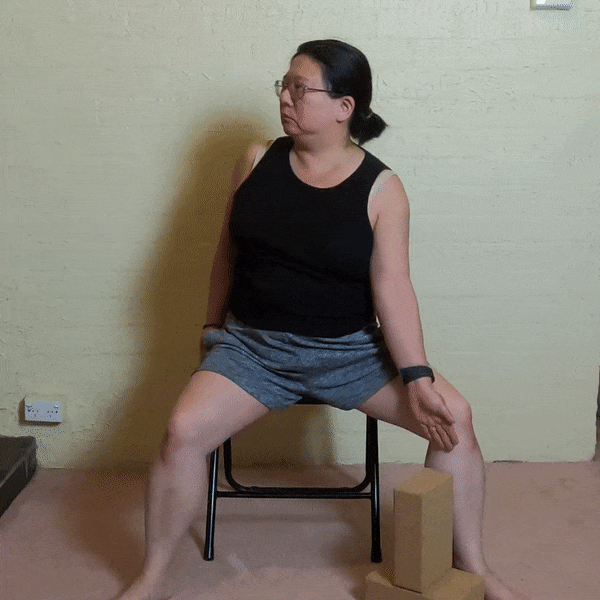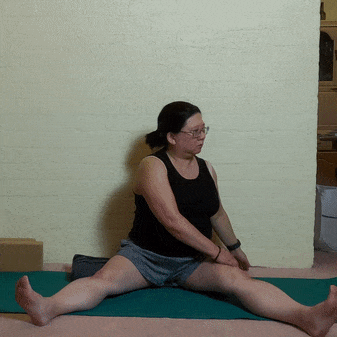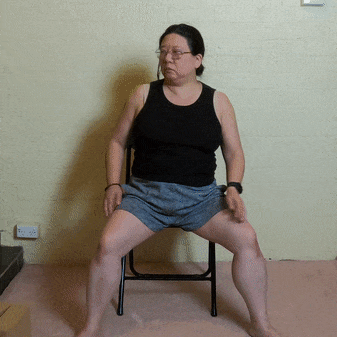Practice Point: Revolved Head-to-Knee Posture
Parivritti janu sirshasana or Revolved Head-to-Knee Posture is another favourite of mine. I love the stretch across my hip and the whole side of my torso, and the feeling of openness that comes from the twist.
I’ve noticed that it appears in a lot of seasonal yoga classes around Spring and Autumn maybe because it stimulates points along the lung and liver meridians, both organs that, in traditional Chinese medicine, are associated with the distribution and regulation of qi (energy) throughout the body.
For some, Revolved Head-to-Knee is a relaxing posture. For others it can be quite stimulating. Experiment and see how it feels for you.
Before you begin ...
The Revolved Head-to-Knee posture comprises a twist and a side bend, which can place a lot of strain and pressure on the spine and abdominal organs.
Seek advice from your medical specialist if you:- Have osteoporosis
- Have back or abdominal problems
- Are pregnant
Instead of this posture you might like to do a gentle side bend or twist such as the swaying palm tree or swinging twist.
Before practising the posture, dynamically warm up the spine with:
- Forward and back bending postures like cat
- Side bending postures like the swaying palm tree
- Twists like the swinging twist
After practising the posture, you might like to do a counterpose that stretches the back (for example, a wide-legged forward fold or extended pose of the child).
The practice
Sit on the floor with the legs extended out in front or sit on a chair with the feet flat on the floor.
Sit tall and have the legs close together.
If you’re sitting on the floor, you might like to try:
- Sitting on something like a blanket, bolster or blocks to raise the hips and lengthen the spine.
- Having a slight bend in the knees and placing a rolled mat or blanket under the knees for support.
If you’re sitting on a chair, sit towards the front of your seat. Have the ankles below or slightly in front of the knees for stability.
Take your left leg out to the side.
If you’re sitting on the floor, keep the left leg extended or bend the knee and bring of the sole of the left foot towards the inside of the right leg. Consider placing a block or cushion under your left knee to support it.
- Choose to keep your right leg out in front or take it out to the right.
For me:
- Keeping the leg extended in front creates more sensation in the twist and less sensation in the side stretch.
- Taking the leg out to the right creates less sensation in the twist and more sensation in the side stretch.
Play with the posture to find the position for your right leg that feels right for you.
Place your right hand or forearm to the inside of your right leg, or rest your hand or forearm on your thigh or a yoga block.
If you're sitting on the floor, you can also choose to hold onto your right big toe (palm facing up and thumb between the big and second toes) or the inside of your right foot.
- Lengthen your spine and turn to your left.
- Bend towards your right leg.
Try sliding your hand or forearm along the inside of your leg to guide the movement, or bend the elbow to support yourself on your thigh or yoga block. If you're holding onto your toe or foot, bend the elbow to draw yourself towards your outstretched leg.
- Gently, turn your chest towards the ceiling.
- Find what feels best for your left arm:
- Bring your left hand behind your back.
- Leave your left arm along your side or slide the left hand up your torso.
- Bring the left hand behind your head and think of taking the elbow behind you and/or up towards the sky.
- Extend your left arm over your head, as if you’re reaching for your right toes.
Turn your head whichever way feels comfortable.
- Hold the posture for as long as you wish.
- To come out of the posture, slowly:
- Lower your arm and let your chest turn back towards the floor.
- Bring the torso upright and then turn to face forward.
- Bring the legs back together in front on the body.
- When you are ready, repeat to the left side.
Breathing
Inhale to lengthen the spine.
Exhale as you twist to one side, bend to the other, and open the chest.
Variations
“Twist and Bend”:
Sit with the legs wide.
If you’re sitting on the floor, you can also sit in a cross-legged position or with the soles of the feet together.
Inhale. Lengthen through your spine and twist to the left.
Place your right hand on or to the outside of the left thigh. If you’re sitting cross-legged or with the soles of the feet together, it might feel more comfortable to place the hand on the knee.
Exhale and bend towards the right.
Keep your left arm relaxed by your side or do one of the following:
Slide your left hand up your torso.
Bring the left hand behind your head.
Extend the left arm over your head.
Hold this position for as long as you wish.
On an inhalation:
Lower the left arm
Bring the torso upright
Release the hold on your left thigh, and
Turn towards the front.
Move to the left side.
Dynamic variation:
Move into the Revolved Head-to-Knee Posture or “Twist and Bend” variation.
Instead of holding the posture:
Inhale. Come upright and let your left hand touch the ground.
Exhale. Bend towards your outstretched leg.
Do 5-7 rounds on each side.
Dynamic side-to-side variation:
Sit with the legs wide. Let your hands relax on your thighs.
Inhale. Lengthen through your spine.
Exhale. Twist to your left before bending to the right.
Let your right hand slide along the inside of your right leg or rest on your right thigh.
Keep your left arm relaxed by your side or let it slide up your torso, place it behind your head, or extend it over head.
Inhale. Straighten the torso and turn to face forward.
Exhale. Twist to your right before bending to the left.
Let your left hand slide along the inside of your left leg or rest on your left thigh.
Keep your right arm relaxed by your side or let it slide up your torso, place it behind your head, or extend it over head.
Inhale. Straighten the torso and turn to face forward.
Continue alternating from side to side, doing about 5-7 rounds on each side.
Dynamic “Twist and Bend” side-to-side variation:
Sit with the legs wide.
If you’re sitting on the floor, you can also sit in a cross-legged position or with the soles of the feet together.
Inhale. Lengthen through your spine and twist to the left.
Place your right hand on or to the outside of the left thigh. If you’re sitting cross-legged or with the soles of the feet together, it might feel more comfortable to place the hand on the knee.
Exhale and bend towards the right.
Keep your left arm relaxed by your side or let it slide up your torso, place it behind your head, or extend it over head.
Inhale.
Straighten the torso, release the left thigh or knee, and let the left arm relax by your side.
Lengthen through your spine and twist to the right.
Place your left hand on or to the outside of the right thigh, or on the right knee.
Exhale and bend towards the left.
Keep your right arm relaxed by your side or let it slide up your torso, place it behind your head, or extend it over head.
Inhale. Straighten the torso, release the right thigh or knee and turn to the other side.
Continue alternating from side to side, doing about 5-7 rounds on each side.
Benefits
Stretches the spine, shoulders, sides of the torso, hips and (if legs are extended) hamstrings
Tones the spinal nerves and muscles
Expands the rib cage, which can improve breathing capacity
Stimulates the lungs, kidney and abdominal organs





